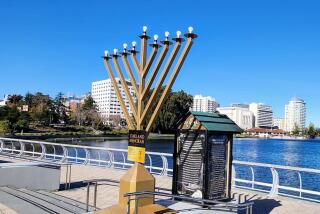NEWS AND BRIEFS : Symbol of Denmark Again Is Vandalized
- Share via
One of the world’s most popular statues, the bronze figure of the Little Mermaid that looks out over Copenhagen harbor, has been vandalized again.
The 76-year-old statue, created by Erik Eriksen in tribute to Danish storyteller Hans Christian Andersen, depicts a winsome mermaid gazing pensively over the water from her perch atop a rock.
Last week a seven-inch cut, apparently made with a hacksaw, was discovered in the back of the statue’s neck. No motive for the vandalism was known and no suspects were in custody.
The statue, which is easily accessible on Langelinie Quay, is visited by about 500,000 tourists a year and has become a Danish national symbol.
The Little Mermaid has been the target of vandals before. The original head was stolen in 1964 and was replaced by a new one cast from the original mold. In 1984 an arm was taken, but it was found and reattached. The mermaid has also been marred by graffiti and paint, and one prankster painted a pink brassiere on her.
The damage will not be permanent. Repair work, which could involve temporary removal of the statue and its rock base or building scaffolding around the statue, is being planned.
Although Copenhagen is in charge of its maintenance, commercial rights to the Little Mermaid statue are owned by Eriksen’s descendants, who earn royalties of about $750,000 a year from the work.
The Litter of the Law: If you plan on visiting Spain this summer and find yourself on the Costa Brava, don’t even think of tossing aside those empty soft drink cans or simply dropping that ice cream wrapper on the street or sidewalk.
In an effort to reduce the litter problem caused largely by tourists, Spanish police have been given authority to fine violators $75, payable right on the spot.
Rials and Dinars: Those are the monetary units in Iran, and if you didn’t know that, you probably aren’t concerned that Tehran has been judged to be the most expensive city in the world.
According to the latest of those international surveys that compare cities by the cost of goods and services, the Iranian capital came in first for the second year in a row, largely because of an overvalued currency.
Tehran is followed by Tokyo and Libreville, the capital of Gabon in West Africa, according to a survey by Corporate Resources Group, a private consulting firm. Oslo remained Europe’s most expensive city for the third straight year, followed closely by Helsinki, Zurich, Geneva and Copenhagen.
Because of a continuous decline in currencies that tended to neutralize soaring inflation, Latin American cities rank among the least expensive.
About a decade ago Buenos Aires was the world’s most expensive city. Today it ranks among the cheapest, only slightly above Quito, Ecuador, which the survey said is the world’s least expensive city.
Japanese Jungle: Tired of the big-city hustle and bustle when visiting Tokyo? Escape is easy. Just half an hour’s drive from the city center is an oasis where visitors can lose themselves amid 4,280 tropical and subtropical plants.
The Yumenoshima Tropical Plant Dome is built on 5,400 square feet of reclaimed land built on waste in Tokyo. High tropical temperatures are maintained by heat piped in from a nearby trash processing plant.
The attraction, which opened last year, was built over a two-year period and cost $18 million.
Airport Security: Two thermal neutron analysis bomb detectors are expected to be fully operational in time for the peak tourist season, according to the Federal Aviation Administration.
Before the end of June one is to be installed at the concourse at London’s Gatwick Airport (a security area serving several U.S. carriers), and the other at the United Airlines area at Washington’s Dulles Airport.
The detectors are the third and fourth devices in a series of six. The first two were installed at the TWA terminal at New York’s Kennedy International Airport and Pan Am’s terminal in Miami. The devices are said to detect all non-commercial explosives, including plastic explosives.
More to Read
Sign up for Essential California
The most important California stories and recommendations in your inbox every morning.
You may occasionally receive promotional content from the Los Angeles Times.













